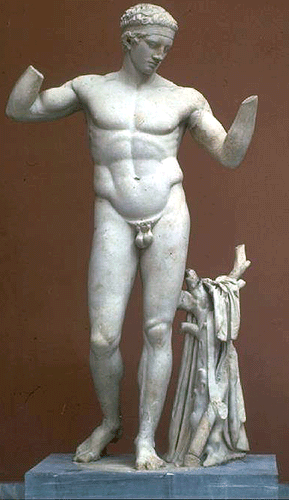
Page 15 of 17
Read the text and study the images below then move on to page 16.
10. Representational qualities
Many sculptures are not respresentational, but if representation is part of their intention then inevitably this aspect becomes an important part of the way we respond to them. Thus we speak of early Greek sculptures being stylized, because they create patterns out of anatomical details such as the Kouros from Sounion. Later examples seem more naturalistic, that is, closer to natural forms. However, the Greeks continued to regulate the way they represented the human figure, so that the forms are more generalised and harmonious than they usually are in nature, and we call these forms idealised. An example of this is the Diadoumenos of Polykleitos.


above Kouros from the Sanctuary of Poseidon in Sounion, marble, 615-590 B.C.. National Museum, Athens.
above Diadoumenos of Polykleitos, marble, c. 430 B.C.. National Museum Athens. (A Roman copy of the ancient Greek sculpture.)
Only when sculptures of the figure are very specific and individualised, do we call them realistic. The way a sculptor creates this effect may vary, from very detailed copying of individual details (sometimes called verism), through to capturing the sense of individuality in a more expressive way, which may involve exaggerating features or posture or facial expression (similar to what might be done in a caricature).